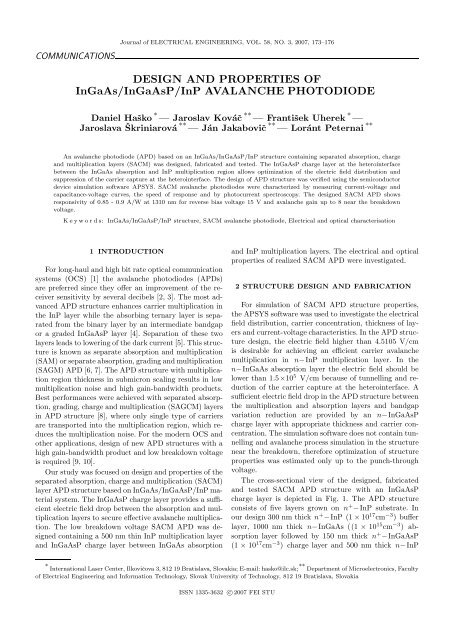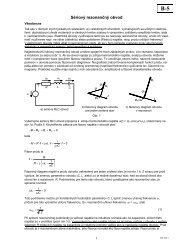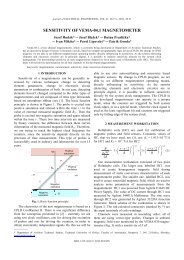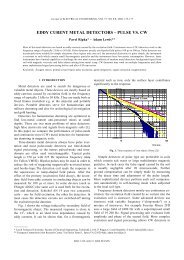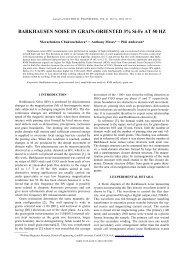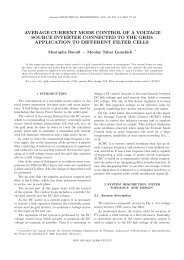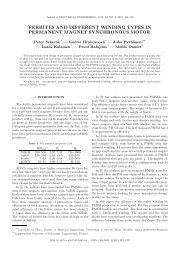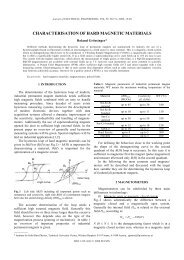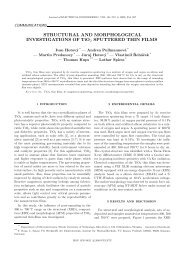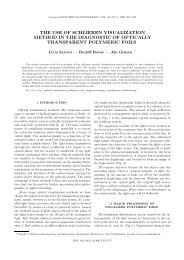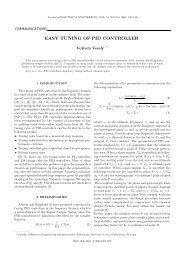DESIGN AND PROPERTIES OF InGaAs/InGaAsP/InP AVALANCHE ...
DESIGN AND PROPERTIES OF InGaAs/InGaAsP/InP AVALANCHE ...
DESIGN AND PROPERTIES OF InGaAs/InGaAsP/InP AVALANCHE ...
You also want an ePaper? Increase the reach of your titles
YUMPU automatically turns print PDFs into web optimized ePapers that Google loves.
COMMUNICATIONS<br />
Journal of ELECTRICAL ENGINEERING, VOL. 58, NO. 3, 2007, 173–176<br />
<strong>DESIGN</strong> <strong>AND</strong> <strong>PROPERTIES</strong> <strong>OF</strong><br />
<strong>InGaAs</strong>/<strong>InGaAs</strong>P/<strong>InP</strong> <strong>AVALANCHE</strong> PHOTODIODE<br />
Daniel Haˇsko ∗ — Jaroslav Kováč ∗∗ — Frantiˇsek Uherek ∗ —<br />
Jaroslava ˇSkriniarová ∗∗ — Ján Jakabovič ∗∗ — Loránt Peternai ∗∗<br />
An avalanche photodiode (APD) based on an <strong>InGaAs</strong>/<strong>InGaAs</strong>P/<strong>InP</strong> structure containing separated absorption, charge<br />
and multiplication layers (SACM) was designed, fabricated and tested. The <strong>InGaAs</strong>P charge layer at the heterointerface<br />
between the <strong>InGaAs</strong> absorption and <strong>InP</strong> multiplication region allows optimization of the electric field distribution and<br />
suppression of the carrier capture at the heterointerface. The design of APD structure was verified using the semiconductor<br />
device simulation software APSYS. SACM avalanche photodiodes were characterized by measuring current-voltage and<br />
capacitance-voltage curves, the speed of response and by photocurrent spectroscopy. The designed SACM APD shows<br />
responsivity of 0.85 - 0.9 A/W at 1310 nm for reverse bias voltage 15 V and avalanche gain up to 8 near the breakdown<br />
voltage.<br />
K e y w o r d s: <strong>InGaAs</strong>/<strong>InGaAs</strong>P/<strong>InP</strong> structure, SACM avalanche photodiode, Electrical and optical characterisation<br />
1 INTRODUCTION<br />
For long-haul and high bit rate optical communication<br />
systems (OCS) [1] the avalanche photodiodes (APDs)<br />
are preferred since they offer an improvement of the receiver<br />
sensitivity by several decibels [2, 3]. The most advanced<br />
APD structure enhances carrier multiplication in<br />
the <strong>InP</strong> layer while the absorbing ternary layer is separated<br />
from the binary layer by an intermediate bandgap<br />
or a graded <strong>InGaAs</strong>P layer [4]. Separation of these two<br />
layers leads to lowering of the dark current [5]. This structure<br />
is known as separate absorption and multiplication<br />
(SAM) or separate absorption, grading and multiplication<br />
(SAGM) APD [6, 7]. The APD structure with multiplication<br />
region thickness in submicron scaling results in low<br />
multiplication noise and high gain-bandwidth products.<br />
Best performances were achieved with separated absorption,<br />
grading, charge and multiplication (SAGCM) layers<br />
in APD structure [8], where only single type of carriers<br />
are transported into the multiplication region, which reduces<br />
the multiplication noise. For the modern OCS and<br />
other applications, design of new APD structures with a<br />
high gain-bandwidth product and low breakdown voltage<br />
is required [9, 10].<br />
Our study was focused on design and properties of the<br />
separated absorption, charge and multiplication (SACM)<br />
layer APD structure based on <strong>InGaAs</strong>/<strong>InGaAs</strong>P/<strong>InP</strong> material<br />
system. The <strong>InGaAs</strong>P charge layer provides a sufficient<br />
electric field drop between the absorption and multiplication<br />
layers to secure effective avalanche multiplication.<br />
The low breakdown voltage SACM APD was designed<br />
containing a 500 nm thin <strong>InP</strong> multiplication layer<br />
and <strong>InGaAs</strong>P charge layer between <strong>InGaAs</strong> absorption<br />
and <strong>InP</strong> multiplication layers. The electrical and optical<br />
properties of realized SACM APD were investigated.<br />
2 STRUCTURE <strong>DESIGN</strong> <strong>AND</strong> FABRICATION<br />
For simulation of SACM APD structure properties,<br />
the APSYS software was used to investigate the electrical<br />
field distribution, carrier concentration, thickness of layers<br />
and current-voltage characteristics. In the APD structure<br />
design, the electric field higher than 4.5105 V/cm<br />
is desirable for achieving an efficient carrier avalanche<br />
multiplication in n−<strong>InP</strong> multiplication layer. In the<br />
n−<strong>InGaAs</strong> absorption layer the electric field should be<br />
lower than 1.5×10 5 V/cm because of tunnelling and reduction<br />
of the carrier capture at the heterointerface. A<br />
sufficient electric field drop in the APD structure between<br />
the multiplication and absorption layers and bandgap<br />
variation reduction are provided by an n−<strong>InGaAs</strong>P<br />
charge layer with appropriate thickness and carrier concentration.<br />
The simulation software does not contain tunnelling<br />
and avalanche process simulation in the structure<br />
near the breakdown, therefore optimization of structure<br />
properties was estimated only up to the punch-through<br />
voltage.<br />
The cross-sectional view of the designed, fabricated<br />
and tested SACM APD structure with an <strong>InGaAs</strong>P<br />
charge layer is depicted in Fig. 1. The APD structure<br />
consists of five layers grown on n + −<strong>InP</strong> substrate. In<br />
our design 300 nm thick n + −<strong>InP</strong> (1 × 10 17 cm −3 ) buffer<br />
layer, 1000 nm thick n−<strong>InGaAs</strong> ((1 × 10 15 cm −3 ) absorption<br />
layer followed by 150 nm thick n + −<strong>InGaAs</strong>P<br />
(1 × 10 17 cm −3 ) charge layer and 500 nm thick n−<strong>InP</strong><br />
∗ International Laser Center, Ilkovičova 3, 812 19 Bratislava, Slovakia; E-mail: hasko@ilc.sk; ∗∗ Department of Microelectronics, Faculty<br />
of Electrical Engineering and Information Technology, Slovak University of Technology, 812 19 Bratislava, Slovakia<br />
ISSN 1335-3632 c○2007 FEI STU
174 D. Haˇsko et al: <strong>DESIGN</strong> <strong>AND</strong> <strong>PROPERTIES</strong> <strong>OF</strong> <strong>InGaAs</strong>/<strong>InGaAs</strong>P/<strong>InP</strong> <strong>AVALANCHE</strong> PHOTODIODE<br />
Fig. 1. Cross-sectional view of <strong>InGaAs</strong>/<strong>InGaAs</strong>P/<strong>InP</strong> SACM APD<br />
structure<br />
Fig. 2. Simulated band diagram of <strong>InGaAs</strong>/<strong>InGaAs</strong>P/<strong>InP</strong> SACM<br />
structure at VB = 0 V<br />
Fig. 3. Simulated electrical field distribution at different reverse<br />
bias voltage VB in <strong>InGaAs</strong>/<strong>InGaAs</strong>P/<strong>InP</strong> SACM structure<br />
(1 × 10 15 cm −3 ) multiplication layer, covered by 1000<br />
nm thick p + −<strong>InP</strong> (1 × 10 18 cm −3 ) contact layer have<br />
been used. The band diagram of the designed structure<br />
at zero reverse bias is shown in Fig. 2, where the bandgap<br />
variation is reduced by inserting n + −<strong>InGaAs</strong>P layer betweeen<br />
<strong>InGaAs</strong> absorption and <strong>InP</strong> multiplication layer.<br />
The electrical field distribution in the structure at different<br />
reverse bias voltages for designed SACM APD is<br />
depicted in Fig. 3.<br />
The lowest value of the electrical field correspond to<br />
zero reverse bias and the highest value to the reverse bias<br />
of VB = 15 V. If the reverse bias increases over 15 V, the<br />
electrical field extends into the absorption layer and this<br />
value correspond to the punch-through voltage. The comparison<br />
between simulated and measured current-voltage<br />
(I − V ) characteristics of the designed SACM APD up<br />
to the punch-through voltage is shown in Fig. 4. The<br />
measured I − V characteristic shows a slightly increased<br />
leakage current and punch-through voltage in comparison<br />
with the simulated characteristic. For the reverse<br />
bias above the punch-through voltage the dark current<br />
increases due to the increased electric field in central active<br />
region with simultaneous extension of the reduced<br />
electrical field into the absorption layer.<br />
SACM APD structure was grown by MOCVD in a single<br />
step and photodiodes were fabricated using standard<br />
photolithography, wet chemical etching and lift-off ohmic<br />
contacts processing. Contact metallization consist of 15<br />
nm sputtered Pt followed by sequential evaporation of 200<br />
nm AuBe alloy onto p type <strong>InP</strong> cap layer. The bottom<br />
contact metallization was formed by evaporation of 200<br />
nm AuGeNi alloy onto <strong>InP</strong> substrate (Fig. 1) followed by<br />
annealing at 400 ◦ C.<br />
3 RESULTS <strong>AND</strong> DISCUSSION<br />
On the selected SACM APD devices with 0.007 mm 2<br />
active area the electrical and optical characteristics were<br />
measured and analyzed. I − V dark current and photocurrent<br />
characteristics under 1310 nm calibrated source<br />
illumination are shown in Fig. 5. The current steps on the<br />
I−V characteristic near 16 V correspond to the extension<br />
of the electrical field into the absorption layer. Within<br />
this mode of operation, the entire charge sheet and absorption<br />
layer are depleted. The photocurrent is flat just<br />
above the punch-through, indicating that the device is<br />
operating near unity gain in this regime.<br />
By increasing the bias voltage over 25 V the carriers<br />
generated within the <strong>InGaAs</strong> absorption layer can drift<br />
into the multiplication region with a high electric field<br />
thus providing an avalanche gain. The breakdown voltage<br />
was estimated near 35 V and avalanche gain up to<br />
8 was reached for mesa shaped devices. The measured<br />
photoresponsivity of the photodiodes without antireflection<br />
coating at 1310 nm was evaluated in the range of<br />
0.85 - 0.9 A/W at a reverse bias voltage of 20 V. Figure<br />
6 shows the capacitance-voltage characteristic, where<br />
the ripples on the curve fit to the extension of the electric<br />
field through heterointerfaces in the structure equally
Journal of ELECTRICAL ENGINEERING 58, NO. 3, 2007 175<br />
Fig. 4. <strong>InGaAs</strong>/<strong>InGaAs</strong>P/<strong>InP</strong> SACM structure I-V characteristics,<br />
simulated and measured<br />
Fig. 6. <strong>InGaAs</strong>/<strong>InGaAs</strong>P/<strong>InP</strong> SACM APD capacitance-voltage<br />
characteristics<br />
to the measured I-V characteristics (Fig. 5). The capacitance<br />
0.65 pF for the bias voltage near the breakdown<br />
of APD was measured. The speed of response of SACM<br />
APD is shown in Fig. 7 in dependence on bias voltages at<br />
1310 nm illumination. The measured rise time at breakdown<br />
was determined as 0.29 ns and fall time as 0.30 ns.<br />
The avalanche gain up to 8 was estimated from the speed<br />
of response amplitudes at the breakdown voltage. Modulation<br />
frequency bandwidth at low gain was measured as<br />
4 GHz and gain-bandwidth product as high as 30 GHz<br />
by a microwave spectral analyzer.<br />
4 CONCLUSION<br />
A novel <strong>InGaAs</strong>/<strong>InGaAs</strong>P/<strong>InP</strong> structure SACM APD<br />
including a 500 nm thick <strong>InP</strong> multiplication layer and a<br />
150 nm thick <strong>InGaAs</strong>P charge layer was simulated, fabricated<br />
and characterized. In simulations, an effective decrease<br />
of the electrical field from multiplication to absorption<br />
layer was achieved by employing an <strong>InGaAs</strong>P<br />
charge layer. The simulated and measured properties of<br />
the designed SACM APD structure exhibit good agree-<br />
Fig. 5. Current-voltage characteristics of <strong>InGaAs</strong>/<strong>InGaAs</strong>P/<strong>InP</strong><br />
SACM APD<br />
Fig. 7. Speed of response characteristics of <strong>InGaAs</strong>/<strong>InGaAs</strong>P/<strong>InP</strong><br />
SACM APD<br />
ment up to the punch-through voltage. For tested mesa<br />
etched avalanche photodiodes with 120 µm diameter, the<br />
breakdown voltage near 35 V and avalanche gain up to<br />
8 under 1310 nm calibrated illumination were achieved.<br />
The measured results revealed that the <strong>InGaAs</strong>P charge<br />
layer could be used to control the electric field profile in<br />
the SACM APD structure.<br />
Acknowledgment<br />
The work at the International Laser Centre was supported<br />
by project No. 1/3076/06 and at the Microelectronics<br />
Department of the Slovak University of Technology<br />
by projects No. 1/2041/05 and No. 1/3108/06, all<br />
from the Slovak Grant Agency. The authors thank A.<br />
Jasik for growing the designed structure at ITME Warsaw,<br />
Poland.<br />
References<br />
[1] RAJAMANI, V.—CHAKRABARTI, P.: A Proposed Ultra<br />
Low-noise Optical Receiver for 1.55 µm Applications, Optical<br />
and Quantum Electronics 35 No. 3 (2003), 195–209.
176 D. Haˇsko et al: <strong>DESIGN</strong> <strong>AND</strong> <strong>PROPERTIES</strong> <strong>OF</strong> <strong>InGaAs</strong>/<strong>InGaAs</strong>P/<strong>InP</strong> <strong>AVALANCHE</strong> PHOTODIODE<br />
[2] HYUN, K. S.—PARK, C-Y.—LEE, E. H.: Gain Characteristics<br />
of <strong>InP</strong>/<strong>InGaAs</strong> Heterostructure Avalanche Photodiode, Material<br />
Science and Engineering B 51 (1998), 106-109.<br />
[3] HAYAT, M. M.—KWON, O-H.—PAN, Y.—SOTIRELIS, P.<br />
—CAMPBELL, J. C. —SALEH, B. E. A. —TEICH, M. C.:<br />
Gain-bandwidth Characteristics of Thin Avalanche Photodiodes,<br />
IEEE Trans. Elec. Dev. 49 No. 5 (2002), 770–781.<br />
[4] BRENNAN, K. F.—HARALSON, J.—PARKSJR., J. W. —SA-<br />
LEM, A.: Review of Reliability Issues of Metal-semiconductor-metal<br />
and Avalanche Photodiode Photonic Detectors, Microelectronics<br />
Reliability 39 No. 12 (1999), 1873–1883.<br />
[5] LIU, Y.—FORREST, S. R.—BAN, V. S.—WOODRUFF, K.<br />
M.—COLOSI, J.—ERIKSON, G. C.—LANGE, M. J.—OLSEN,<br />
G. H.: Simple, Very Low Dark Current, Planar Long-wavelength<br />
Avalanche Photodiode, Appl. Phys. Lett. 53 No. 14<br />
(1988), 1311–1313.<br />
[6] BUDIANU, E.—PURICA, M.—RUSU, E.: Heterostructures<br />
on <strong>InP</strong> Substrate for High-speed Detection Devices over a<br />
Large Spectral Range (0.8-1.6 µm), Microelectronic Engineering<br />
51-52 (2000), 393–400.<br />
[7] ANSELM, K. A.—NIE, H.—HU, C.—LENOX, C.—YUAN,<br />
P.—KINSEY, G.—CAMPBELL, J. C.—STREETMAN, B. G. :<br />
Performance of Thin Separate Absorption, Charge, and Multiplication<br />
Avalanche Photodiodes, IEEE J. of Quantum Electronics<br />
34 No. 3 (1998), 482–490.<br />
[8] AN, S.—DEEN, M. J.—VETTER, A. S.—CLARK, W. R.<br />
—NOEL, J-P. —SHEPHERD, F. R. : Effect of Mesa Overgrowth<br />
on Low-Frequency Noise in Planar Separate Absorption,<br />
Grading, Charge, and Multiplication Avalanche Photodiodes,<br />
IEEE J. of Quantum Electronics 35 No. 8 (1999), 1196–1202.<br />
[9] WATANABE, I.—NAKATA, T.—TSUJI, M.—MAKITA, K.—<br />
TORIKAI, T.—TAGUCHI, K.: High-Speed, High-Reliability<br />
Planar-Structure Superlattice Avalanche Photodiodes for<br />
10 Gb/s Optical Receivers, J. Lightwave Technol. 18 (2000),<br />
2200-2207.<br />
[10] CAMPBELL, J. C.—DEMIGUEL, S.—MA, F.—BECK, A.<br />
—GUO, X. —WANG, S. —ZHENG, X. —LI, X. —BECK, J.<br />
D. —KINCH, M. A. —HUNTINGTON, A. —COLDREN, L. A.<br />
—DECOBERT, J. —TSCHERPTNER, N.: Recent Advances<br />
in Avalanche Photodiodes, IEEE J. of Sel. Top. in Quantum<br />
Electronics 10 No. 4 (2004), 777–487.<br />
Received 17 September 2005<br />
Revisited 15 December 2006<br />
Daniel Haˇsko (Ing, PhD) was born in Pieˇst’any, Slovakia,<br />
in 1975. He received his Ing (MSc) and PhD degrees in electrical<br />
engineering from STU, Bratislava, in 1999 and 2006. From<br />
SLOVART G.T.G.<br />
s.r.o.<br />
GmbH<br />
E X P O R T - I M P O R T<br />
E X P O R T - I M P O R T<br />
of periodicals and of non-periodically<br />
printed matters, books and CD - ROM s<br />
Krupinská 4 PO BOX 152, 852 99 Bratislava 5,Slovakia<br />
tel.: ++ 421 2 638 39 472-3, fax.: ++ 421 2 63 839 485<br />
e-mail: gtg@internet.sk, http://www.slovart-gtg.sk<br />
1999 to 2001 he worked on his PhD at Microelectronic Department<br />
of STU dealing with photodetectors. From 2002 to<br />
2004 he worked as a research worker in the section of research<br />
and development of optoelectronic and microwave elements<br />
at Microelectronics Department of STU Bratislava. In 2005<br />
he joined the International Laser Centre in Bratislava, where<br />
he is engaged in semiconductors materials surface characterization<br />
in the surface and materials analysis laboratory.<br />
Jaroslav Kováč (Prof, Ing, PhD) was born in ˇ Safárikovo,<br />
Slovakia, in 1947. He graduated from the FEI STU, Bratislava,<br />
in 1970. Since 1971 he has been engaged in the research of<br />
optoelectronic devices technology at the Microelectronics Department<br />
of FEI STU. He received a PhD degree from STU<br />
Bratislava, in 1983. Since 1991 he is the team leader of the<br />
Optoelectronic and microwave group at the Department of<br />
Microelectronics.<br />
Frantiˇsek Uherek (Prof, Ing, PhD) was born in Zlín,<br />
Czech Republic, in 1954. He received the Ing (MSc) and PhD<br />
degrees from FEI STU, Bratislava, in 1979 and 1989, respectively.<br />
In 1980 he joined the Microelectronics Department of<br />
FEI STU. At present he is full professor and vice-head of the<br />
department. His main interests are optoelectronics, optoelectronic<br />
devices and their applications.<br />
Jaroslava ˇSkriniarová (Ing, PhD) received her Ing<br />
(MSc) and CSc (PhD) degrees from the Slovak University of<br />
Technology (STU), Bratislava, in 1977 and 1986. In 1993 she<br />
joined the Microelectronics Department of STU. At present<br />
she is there engaged in the research of optoelectronic devices,<br />
especially of wet etching processes.<br />
Ján Jakabovič (Ing, PhD) was born in Sered’, Slovakia,<br />
in 1951. He received his Ing (MSc) and PhD degrees in electrical<br />
engineering from STU, Bratislava, in 1974 and 2005. From<br />
1974 to 1976 he worked at the Czechoslovak Metrological Institute<br />
in research of Josephson junction devices. In 1976 he<br />
joined the Microelectronics Department of STU Bratislava,<br />
where he is engaged in the research of optoelectronic devices,<br />
especially device processing and organic electronics.<br />
Loránt Peternai (Ing, PhD) was born in ˇ Surany, Slovakia,<br />
in 1977. He received his Ing (MSc) degree in electrical<br />
engineering from STU, Bratislava, in 2002. From 2002 to 2005<br />
he worked on his PhD at Microelectronic Department of STU<br />
dealing with LEDs. In 2006 he joined the Microelectronics<br />
Department of STU Bratislava, where he is engaged in the research<br />
of optoelectronic devices, especially of ohmic contacts,<br />
and as a teacher.<br />
SLOVART<br />
G.T.G.<br />
s.r.o.<br />
GmbH<br />
E X P O R T - I M P O R T


